Power Hitters: MLB Stadiums and Solar
Across the country and around the world, professional sports stadiums dominate skylines and create a sense of pride for their communities. Although empty for the most part during the global pandemic, these structures—occupied or otherwise—consume massive amounts of energy each year and face unique challenges when it comes to operating sustainably.
For instance, American professional baseball stadiums average an enormous 1 million square feet in size and typically host over 70 million fans collectively in a year. Depending on their construction, these stadiums can consume millions of kilowatt-hours (kWh) annually under normal operation. From running the jumbotron and the outfield lighting to cooking hotdogs and other concessions, it takes a lot to power “America’s Pastime.”
Fortunately, some ballclubs have started looking at renewable energy sources like solar to help lower their environmental footprints and ensure more sustainable operations. So far, ten of the thirty Major League Baseball (MLB) stadiums have added solar panels to their roster, and baseball is not the only sport taking advantage. Solar installations are currently being utilized at NFL, NBA, NHL, MLS, NASCAR, and IndyCar venues as well. All told, America’s sports stadiums have built over 46 megawatts of solar capacity, half of which came online after 2015.
SUSTAINABILITY IN MAJOR LEAGUE BASEBALL
A single MLB stadium may use upwards of tens of millions of kWh each year, depending on seating capacity and attendance. Additional stadium features like retractable roofing or large screens will also dictate peak energy consumption. To help with these colossal energy demands, MLB stadiums are turning to commercial solar panels and other energy efficiency improvements to lower their costly energy bills and carbon footprints.
The expansive physical footprint of professional ballparks often offers plenty of location options for integrating solar. Among the ten solar-powered MLB stadiums, solar panels have been installed in the outfield, on ticketing buildings, parking garages, and stand-alone pavilions. The systems vary in size, allowing some stadiums to power hundreds of small televisions or one giant television (the scoreboard) or even an entire front office building.
While embracing solar helps lower a stadium’s energy bills, it also demonstrates the organization’s environmental values to the fans, which can go a long way in building a team and community pride. Professional sports venues have an incredible opportunity when it comes to promoting and showcasing sustainability improvements, as well as educating their fans on the need for renewable energy, in particular. Millions of fans typically enter stadiums every year, but there’s also enormous overlap between professional sports and other major industries that are involved either as sponsors or as vendors. Given their high cultural significance, professional sports teams can have a big impact on the environment.
Besides solar, the MLB has also embraced a multitude of other sustainability strategies to lower the environmental impact of its parks, including waste diversion, composting, water conservation, and energy efficiency improvements for lighting and HVAC. For example, nineteen ballparks have switched to LEDs for their field lighting, and twelve ballparks have built on-site gardens that provide concessions and restaurants with fresh, ultra-local food.
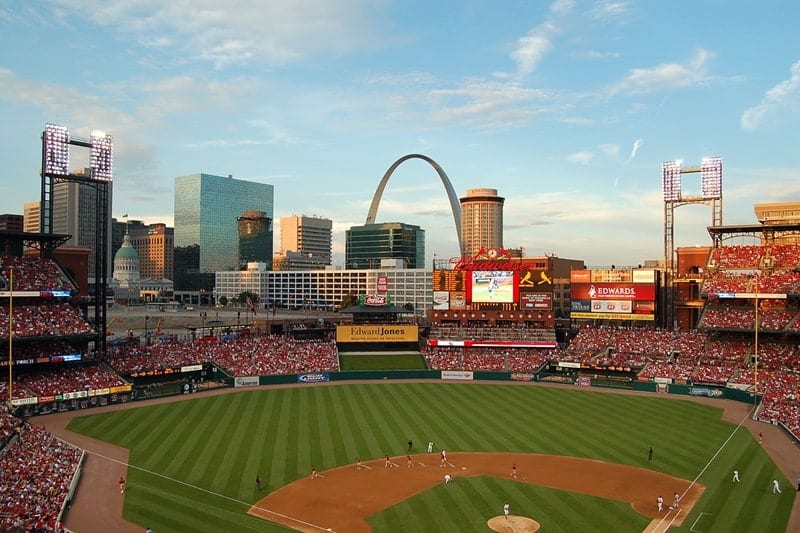
IS YOUR TEAM SOLAR POWERED?
Here are the ten MLB stadiums that are currently taking their game to the next level with solar power.
- Busch Stadium – St. Louis Cardinals
- Chase Field – Arizona Diamondbacks
- Coors Field – Colorado Rockies
- Fenway Park – Boston Red Sox
- Kauffman Stadium – Kansas City Royals
- Nationals Park – Washington Nationals
- Oracle Park – San Francisco Giants
- Petco Park – San Diego Padres
- Progressive Field – Cleveland Indians
- T-Mobile Park – Seattle Mariners
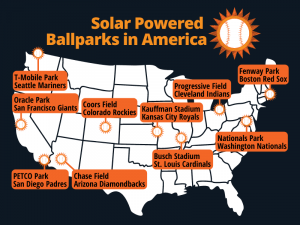
BUSCH STADIUM
BUSCH STADIUM – ST. LOUIS CARDINALS
It is essential to keep up with the times. That is why the St. Louis Cardinals team name is no longer the “Brown Stockings” and why Busch Stadium in St. Louis, Missouri, installed 106 solar panels on the roof of the ticket building and atop a canopy in the left-centerfield bleachers in 2012.
“This is all part of the St. Louis Cardinals’ commitment to green its game,” said Joe Abernathy, vice president, stadium operations at Busch Stadium. “Since the stadium opened in 2006, we’ve been able to cut our energy use by 20 percent and water use by 10 percent.”
The Cardinals partnered with Microgrid Energy, the Electrical Connection, and Sachs Electric to install the 25 kW system, which includes Schott 240W and 235W solar modules, at the 1.2 million square foot facility. The Busch Stadium solar power system is expected to generate 32,000 kWh each year, which will offset the grid power used by stadium operations, reduce electricity bills, and save the organization a significant amount of money over the life of the system.
“Sachs Electric has served the Cardinals for more than 70 years, including the floodlighting and electronic scoreboard at Sportsman’s Park for the first night game ever played in St. Louis,” said Joe Barnard, vice president at Sachs Electric. “It’s a pleasure to help the Cardinals usher in a new era of renewable energy in a form that educates the public as well.”
To celebrate the system’s completion, the Cardinals designated a “solar day” for April 29, 2012, complete with solar activities for all attending fans. To raise awareness for solar energy, the stadium also features an educational kiosk in Ford Family Plaza, which provides information about the project.
Read about other sustainability initiatives at Busch Stadium and within the St. Louis Cardinals organization on the stadium’s website.
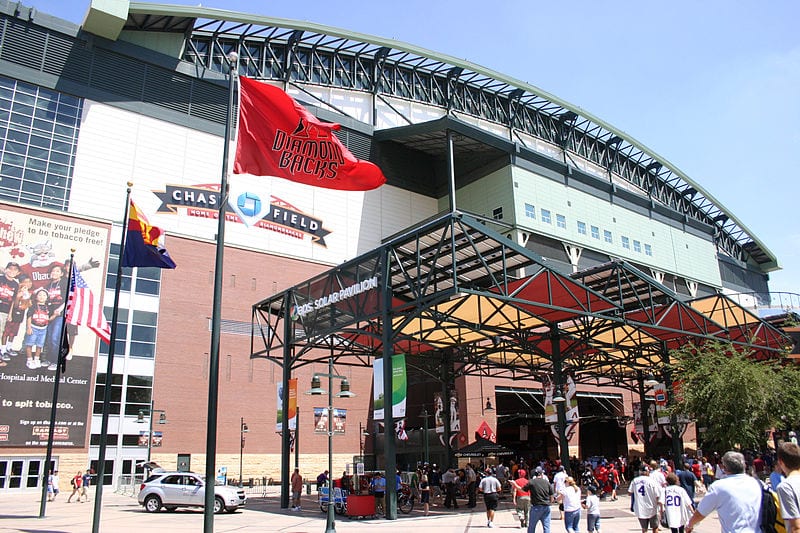
CHASE FIELD
CHASE FIELD – ARIZONA DIAMONDBACKS
Chase Field in Phoenix has no shortage of sunshine. Thankfully fans of the Arizona Diamondbacks have some reprieve from the intense Arizona sun during games in the form of the 17,280 square foot APS Solar Pavilion. Completed in 2011, the 77.3 kW solar system provides around 100,000 kWh of energy each year or enough to power 11 of the park’s home games.
“The solar structure will not only further distinguish the D-backs’ green initiatives among professional sports teams, but it will also provide needed shading near the ballpark to enhance our fan experience during the hot summer months,” said D-backs President and CEO Derrick Hall. “This innovative project will be on display when baseball fans from around the world visit downtown Phoenix in July to attend the All-Star Game at Chase Field.”
The Chase Field solar system features 336 Solon 230 W solar panels elevated to form a canopy outside the stadium’s west entrance, where roughly 75% of attendees enter the park. Arizona Public Service (APS), the local investor-owned utility, owns the system and any Solar Renewable Energy Credits (SRECs) produced by the system, which helps the utility meet the state’s renewable energy mandates. APS plans to use the system, which has an expected lifespan of 20 years, as a technical demonstration project for charging batteries and electric vehicles from the sun.
“This new structure represents Maricopa County’s ongoing commitment to green practices and sustainability through a unique public-private partnership dedicated to enhancing the quality of life for the citizens of the county and Chase Field,” said Andrew Kunasek, Chairman of the Maricopa County Board of Supervisors, which also serves as the Stadium District’s governing board.
The Diamondbacks have also installed low-flow sinks and toilets, LED concourse lights, and electric vehicle charging stations at Chase Field. Other green efforts include a vertical urban garden and concession uniforms made from recycled plastic.
Read more about the sustainability initiatives at Chase Field on the stadium’s website.
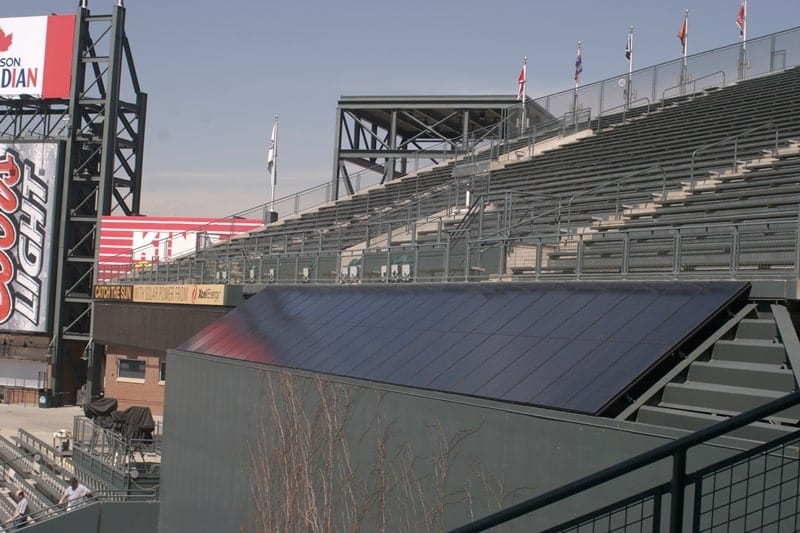
COORS FIELD
COORS FIELD – COLORADO ROCKIES
The Colorado Rockies became one of the first professional baseball clubs to go solar when they added a 9.89 kW high-efficiency commercial solar power system just in time for Opening Day 2007. The Coors Field solar panels are the result of a partnership between the Rockies and Xcel Energy, which commissioned Independent Power to install the array.
In total, the system produces over 14,000 kWh annually—enough to offset the consumption of the Rockpile LED board each year. In the walkway just beneath the system, a flat-panel monitoring system displays the real-time consumption of the Rockpile LED board and the real-time energy production from the solar array.
“This solar project delivers on the Colorado promise of the ‘New Energy Economy’ that I have been speaking about all over the state,” said Colorado Governor Bill Ritter at the time. “I congratulate the Rockies for their leadership and call upon Major League Baseball, the NFL, and stadium owners throughout the nation to follow the example we’ve set by deploying solar at Coors Field.”
The monocrystalline SunPower solar panels at Coors field are expected to last more than 25 years, ensuring a steady supply of clean energy and thousands in energy savings for the ballpark over the system’s life. The installation used an all-black racking system to blend seamlessly into the stadium’s aesthetic.
“Solar power is an essential component of our global energy mix, and companies such as Independent Power and Xcel Energy are doing their part to ensure that it is an easy, affordable option for home and commercial use,” said Tom Werner, chief executive officer of SunPower. “The Rockies have distinguished their organization as a leader by bringing clean, renewable energy to a great American sport.”
Read more about the Coors Field solar panels and other Colorado Rockies sustainability initiatives on the Colorado Rockies Green Campaign page.
FENWAY PARK – BOSTON RED SOX
Fenway Park, home of the Boston Red Sox, is one of the oldest stadiums in use, but that doesn’t mean the ballpark was slow to get with the times. In 2008, the team took a slightly different approach to clean energy, installing 28 solar thermal panels behind the home plate. Instead of generating electricity, these solar thermal panels use the sun to heat the park’s water, which means less energy and expense is needed for gas-powered water heaters.
The panels have reduced the natural gas demand for water heating by 37%, avoiding 18 tons of CO2 emissions annually.
Following a 2010 complete energy audit of their facility, Fenway’s stadium operators also began a series of sustainability upgrades and initiatives throughout the park, including LED retrofits and the creation of recycling and composting programs.
Learn more about the sustainability initiatives at Fenway Park.
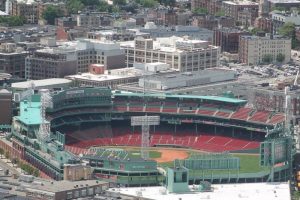 ”
”
KAUFFMAN STADIUM
KAUFFMAN STADIUM – KANSAS CITY ROYALS
Once the largest in-stadium solar power system in the league, the 120 solar panels on the roof of Kauffman Stadium in Kansas City, Missouri, are a testament to the Kansas City Royals’ commitment to sustainability and maximizing renewable energy resources at the ballpark.
Installed in 2012 by KCP&L, the 28.8 kW system produces approximately 36,000 kWh each year, which is enough to offset a small portion of the stadium’s annual energy use (or to power four to six regular-sized homes). The solar installation was a part of a wider green campaign that includes food composting programs and energy efficiency improvements for the outfield fountains that celebrate every Royals’ home run.
“The Royals are committed to making Kauffman Stadium one of the most environmentally-friendly facilities in sports,” said Kevin Uhlich, Royals Senior Vice President-Business Operations, at the time. “We are excited to partner with KCP&L to bring the latest technologies in sustainable energy to the ballpark, especially as we prepare for the 2012 All-Star Summer.”
The string of solar panels is divided into two groups atop the canopy of Kauffman Stadium’s Outfield Experience, 60 on either side of the CrownVision board, which can be seen from any seat in the park. The panels face south toward home plate, but the Royals will not have to worry about any glare.
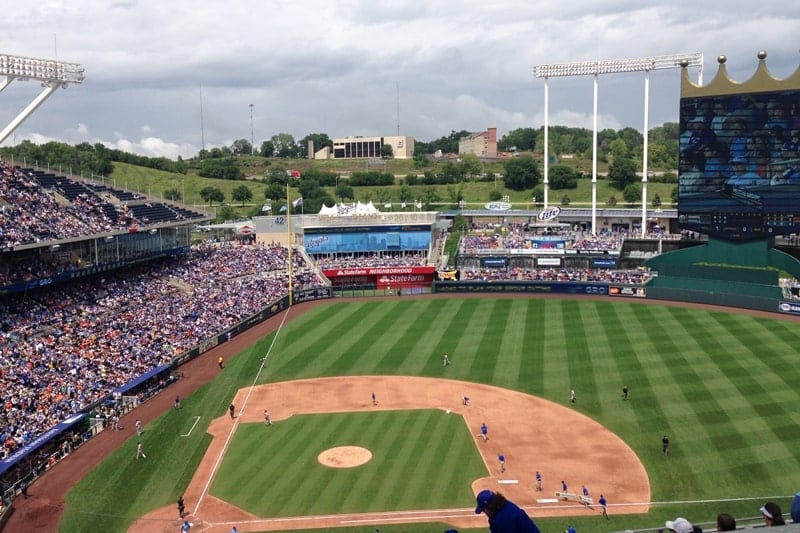
NATIONALS PARK
NATIONALS PARK – WASHINGTON NATIONALS
When Nationals Park opened in 2008, it made headlines as the first U.S. sports stadium to earn the LEED (Leadership in Energy and Environmental Design) Silver certification. Energy-efficient lighting, low-flow water features, and a 6,000 square foot green roof just beyond left field all helped Nationals Park earn it’s certified green building status.
In 2019, the Washington Nationals announced they were taking their commitment to sustainability to the next level by adding 4,080 solar panels integrated into a solar canopy above two parking garages. The 1.46 megawatt (MW) solar array is the largest at any MLB stadium, generating approximately 1,890 megawatt-hours (MWh) of electricity annually, enough to cover 10% of the park’s energy demand.
Is it a coincidence that the Nationals installed the largest solar power system in the Major Leagues and then went on to win the World Series the same year? We’ll let you decide.
Read more about the sustainable elements of Nationals Park here.
Looking for sustainability in the National Parks instead? We have an article on that too!
ORACLE PARK
ORACLE PARK – SAN FRANCISCO GIANTS
Oracle Park, formerly AT&T Park, was one of the first solar adopters in the MLB. In 2007 the Giants, in partnership with PG&E, installed 590 Sharp solar panels in three different locations in the park for a total system power output of 123 kW. Introduced at the 2007 All-Star Game, the system is expected to generate enough energy annually to power the Giant’s scoreboard. However, most of the system’s production will be fed back into the grid served by PG&E for use by customers throughout Central and Northern California.
“California is the third-largest solar market in the world and has long been a leader in the adoption of solar energy in the U.S. The Giants have taken a pioneering step in promoting solar electricity to California residents by making it an integral part of the baseball experience,” said Ron Kenedi, vice president, Solar Energy Solutions Group, Sharp. “As the U.S. market leader, we are happy to assist the Giants and PG&E in showcasing the positive benefits of solar electricity to consumers through one of America’s favorite pastimes.”
Complimenting their renewable energy efforts, the SF Giants also host a league-leading recycling program. The Green Glove is an award given every year to the MLB park with the highest waste diversion rate. Oracle Park has won the Green Glove ten out of the eleven years that it’s been available.
In 2019, Oracle Park achieved LEED Platinum Certification from the U.S. Green Building Council (USGBC) for their continued efforts to conserve energy and water, implement renewable energy sources throughout the park, and recycle whenever possible. The stadium previously achieved LEED Silver Certification in 2010 and LEED Gold Certification in 2015.
Read more about the sustainability initiatives at Oracle Park.
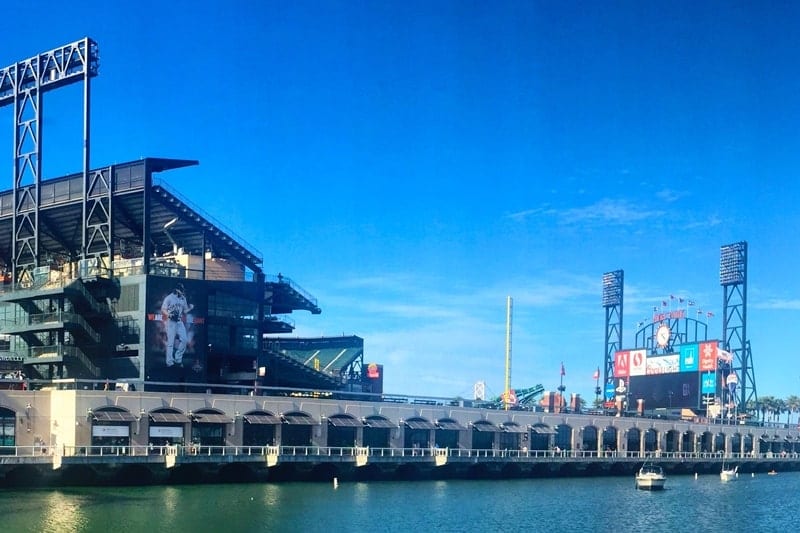
PETCO PARK
San Diego has not won a World Series yet, but take solace Padre fans, you’ve got a lot of sun and the largest in-stadium solar installation (for now). In 2018, Petco Park added a 336.52 kW solar panel system consisting of 716 high-efficiency SunPower X-series 470 W commercial solar modules, completed by March, just before Opening Day. The system is expected to generate over 12 million kWh and $4 million in energy savings for the ballpark over the predicted 25-year lifespan of the panels.
“With Petco Park serving as the premier sports and entertainment venue in San Diego, we take pride in continuing to make it the most energy-efficient and sustainable facility possible,” said Padres Chief Operating Officer Erik Greupner. “We are pleased to partner with Sullivan Solar Power on this project, which represents a further step by the Padres to improve the energy efficiency and sustainability of Petco Park.”
The stadium installation also gets the city of San Diego one step closer to its goal of achieving 100% renewable energy by 2035.
“San Diego continues to lead the way on climate action as we march toward our ultimate goal of 100 percent renewable energy,” Mayor Kevin Faulconer said. “We are going to need great, committed partners in the business community to do their part in order to get there. That’s why I’d like to commend the Padres for turning the best ballpark in the country into one of the most environmentally-friendly. Petco Park will serve as a model for the rest of Major League Baseball and as an example for other San Diego businesses to follow.”
In addition to the large solar installation on the ballpark’s upper deck roof canopy, the Padres have also undertaken various other efficiency improvements throughout the facility, including replacing 768 metal halide light fixtures with 400 LED equivalent fixtures in 2015.
Read more about the Padres Environmental Sustainability Program and other green initiatives at Petco Park.
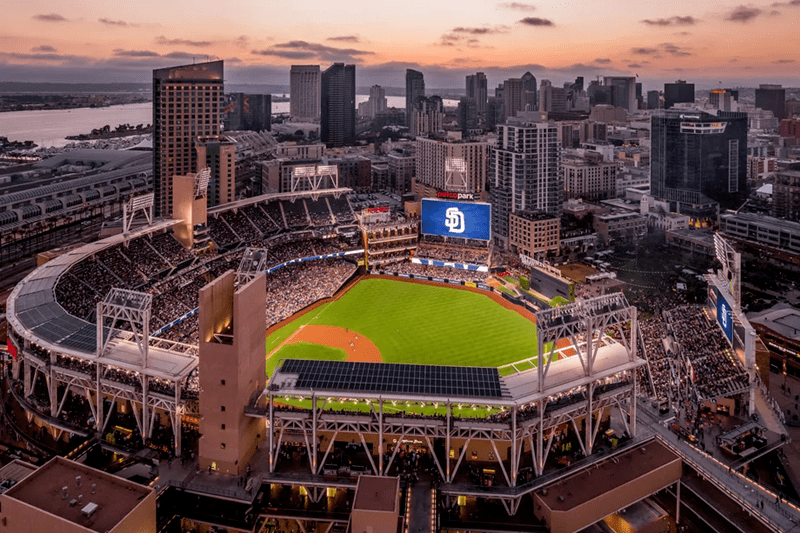
PROGRESSIVE FIELD
PROGRESSIVE FIELD – CLEVELAND INDIANS
Like the Rockies and Giants, the Cleveland Indians were another early adopter of on-site renewable energy, installing a 42-panel solar electric system at the aptly-named Progressive Field in June 2007. According to the Indians, the 8.4 kW solar power system generates enough energy to power the stadium’s more than 400 televisions. In 2019, it was announced that the Indians would be adding additional solar panels on the roof behind the home plate to reduce energy costs further and expand the ballclub’s sustainability initiatives.
“The Cleveland Indians organization is committed to helping preserve the environment by using advanced energy and green options,” said Jerry Crabb, Indians Senior Director of Ballpark Operations. “We understand the responsibility of being environmentally conscious within the walls of Progressive Field and beyond. Using sustainable technologies is not only good for the community but good for baseball.”
Progressive Field also holds the distinction of being the first MLB stadium to install a wind turbine. However, the demo project by Cleveland State University had to be terminated early due to wind damage sustained by the experimental turbine during the off-season.
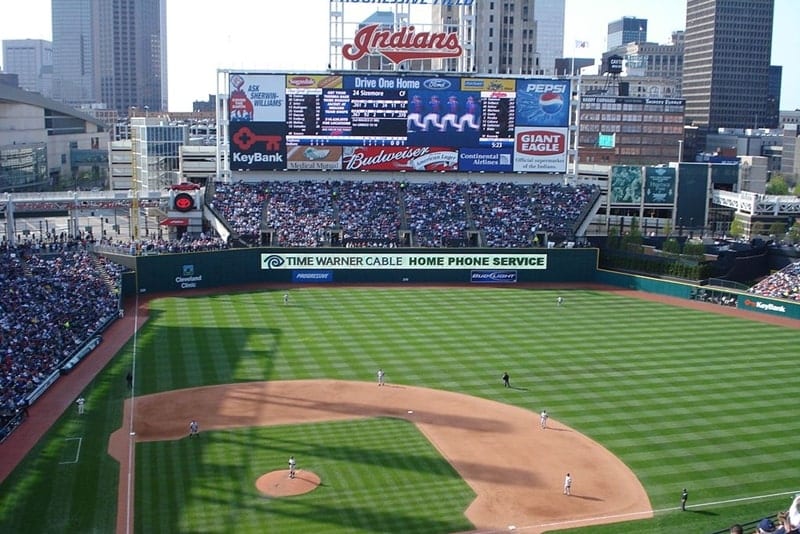
T-MOBILE PARK
T-MOBILE PARK – SEATTLE MARINERS
Yes, even rainy Seattle can benefit from solar power. In 2012, the Mariners installed a 32.76 kW system on top of the parking garage at T-Mobile Park (formerly Safeco Field). The persistent cloud cover does not stop the 168 Panasonic solar panels from producing an average of 40,000 kWh each year, which is fed into the T-Mobile Park distribution grid. That is enough to offset 28 metric tons of CO2 emissions.
“The Mariners have a commitment to sustainability, and our system will help them achieve their goals by using a natural power source, the sun, to reduce [T-Mobile Park’s] energy costs, said Jim Doyle, President of the Panasonic Enterprise Solutions Company. “By making fans aware of how solar energy generation, even in places like Seattle, can make a difference for any site, perhaps more people will consider adopting solar power for their own energy needs.”
There are monitors in the stadium that show the fans the real-time generation of the solar power system.

KNOCK IT OUT OF THE PARK WITH SOLAR
All told, there is currently over 2.1 MW of installed solar capacity in America’s MLB stadiums. In addition to lowering their energy bills and environmental footprints, these ballparks are demonstrating their commitment to renewable energy and sustainability in front of a global audience.
While there is no firm evidence that solar power will mean a better season for the home team, it should be noted that—over the past 20 years—10 World Series Champions have had solar-powered stadiums. Considering only a third of MLB stadiums have solar today, that’s pretty significant.
If your team has been in a slump, maybe it’s time to petition to get solar added to your ballpark!
